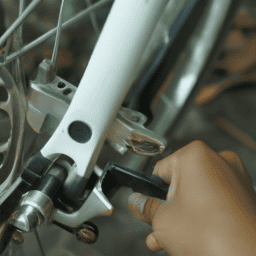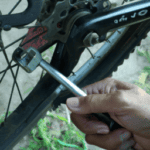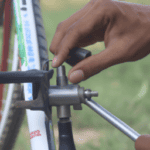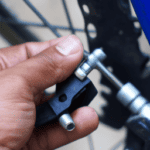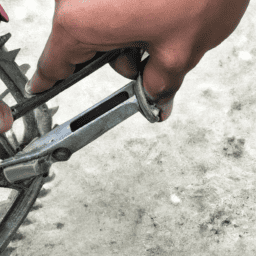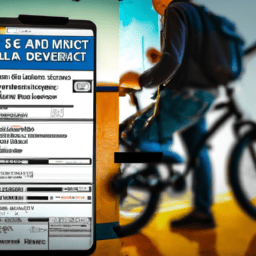Tweaking the brakes on your bike might appear straightforward, however, I assure you, it can significantly impact whether your ride is secure or hazardous. The last thing you want is to be speeding down a slope to find out your braking system is faulty. This is why I’m dedicated to showing you how to fine-tune your bike’s brakes with specificity, accuracy, and thoroughness.
Whether you’re dealing with rim brakes or disc brakes, I’ll walk you through the steps to assess and adjust them properly. Not only will you learn how to adjust your brakes, but I’ll also give you tips on how to maintain them to ensure a safe and enjoyable riding experience.
So, let’s get started and make sure your brakes are in tip-top shape!
Key Takeaways
- Different types of brakes require different adjustment methods.
- Proper brake pad placement and minimal wear ensure maximum stopping power.
- Regularly inspect and adjust brakes for optimal performance, and use appropriate lubricants to prevent rust and ensure smooth operation.
- Neglecting brake maintenance can lead to serious accidents and injuries, so it is important to troubleshoot any performance issues and address them promptly.
Assess Your Brakes
You’ll want to start by assessing your brakes, making sure they’re functioning properly before making any adjustments.
Begin by examining the brake pads. Look for any wear indicators that may be present on the pads. These indicators will let you know when it’s time to replace the pads. If the pads are worn down to the point where the indicators are visible, it’s time to replace them.
The next step is to check the thickness of the brake pads. Use a brake pad thickness gauge to measure the thickness of the pads. The minimum thickness for most brake pads is 1mm. If the pads are thinner than this, they need to be replaced.
Once you’ve determined that the pads are in good condition, you can move on to adjusting the brakes.
Adjusting Rim Brakes
When squeezing the lever on rim brakes, the rubber pads should press against the metal rim of the wheel to slow down the bike. If the brakes are not functioning properly, the first thing to check is the brake pad position.
The brake pads should be positioned so that they are parallel to the rim and centered over it. If the pads are worn or misaligned, they may need to be replaced or adjusted.
Next, you should check the cable tension. If the cable is too loose, the brake pads won’t engage properly and won’t provide enough stopping power. If the cable is too tight, the brakes may drag on the rim and cause excessive wear.
To adjust the cable tension, locate the barrel adjuster on the brake lever and turn it clockwise or counterclockwise as needed. Once you have adjusted the brake pads and cable tension, test the brakes to ensure that they are functioning properly.
Moving on to the next section about adjusting disc brakes, it’s important to note that while rim brakes and disc brakes operate similarly, the method for adjusting them is slightly different.
Adjusting Disc Brakes
So, when it comes to adjusting disc brakes on my bicycle, I always start by loosening the caliper bolts to allow for some movement.
Then, I align the brake pads so they’re properly situated on the rotor.
Finally, I tighten the caliper bolts back up to ensure everything stays in place.
It’s important to take the time to adjust disc brakes properly to ensure maximum stopping power and safety while riding.
Loosen the Caliper Bolts
First, loosen the caliper bolts by gently turning them counterclockwise with a wrench until they feel as loose as a noodle in boiling water. It’s important to know how to properly loosen and tighten caliper bolts for bicycle brake adjustment to avoid stripped bolts during adjustment. When loosening the bolts, be mindful of the amount of force you’re using. You don’t want to over-torque the bolts, as this can cause them to strip and make future adjustments difficult.
To further emphasize this point, here’s a table with some tips for avoiding stripped bolts during adjustment:
| Tip | Description |
|---|---|
| Use a torque wrench | This tool allows for precise tightening without over-torquing |
| Use proper tools | Using the correct size wrench or Allen key can prevent stripping |
| Apply anti-seize lubricant | This can help prevent corrosion and make future adjustments easier |
| Don’t force it | If a bolt is stuck, try using penetrating oil or heat to loosen it instead of excessive force |
Now that the caliper bolts are loosened, it’s time to move on to aligning the brake pads.
Align the Brake Pads
Now that the caliper bolts are loose, it’s time to get those brake pads in perfect alignment to ensure maximum stopping power on your ride. Proper pad placement is essential for the brake system to work efficiently.
Start by checking the wear on your current brake pads. If the pads are worn unevenly, it may be time to replace them with new ones.
Next, align the brake pads with the rim of the wheel. Make sure the pads are centered and that they don’t touch the tire. A good technique is to look at the gap between the pad and the rim. You want the gap to be equal on both sides. Once the pads are in the right position, tighten the bolts that hold the pads in place.
To ensure that the brake pads are properly aligned, you should test the brakes by spinning the wheel and applying the brakes. If the wheel stops smoothly and quickly, then you’ve successfully aligned the pads. If not, adjust the pads as needed until you get the desired result.
With proper pad placement and minimal brake pad wear, your bike will stop on a dime. Now, it’s time to move on to the next step: tightening the caliper bolts.
Tighten the Caliper Bolts
Once the brake pads are aligned, it’s important to tighten the caliper bolts to ensure they stay in place. Proper torque is crucial to prevent the bolts from loosening during use. I recommend using a torque wrench to tighten the bolts to the manufacturer’s specifications.
Over-tightening can cause damage to the bolts and the frame, while under-tightening can lead to a loss of braking power. It’s important to check the bolts periodically to ensure they’re still tight.
Caliper alignment is also important when tightening the bolts. If the caliper is misaligned, it may cause uneven wear on the brake pads and decrease the effectiveness of the braking system.
Before tightening the bolts, make sure the caliper is centered over the rotor. You can use a specialized tool or simply eyeball it. Once everything is aligned, tighten the bolts evenly on both sides, alternating between them until they’re snug.
Now that the caliper bolts are tightened, it’s time to test your brakes.
Test Your Brakes
Now that I’ve adjusted my disc brakes, it’s important to test their performance to ensure that they’re functioning properly.
Firstly, I’ll check the brake lever tension to make sure that it’s not too loose or too tight.
Next, I’ll test the braking performance by riding my bike at a moderate speed and applying the brakes. If the brakes aren’t stopping my bike effectively, I’ll make further adjustments as needed to make sure that they’re working at their best.
Check Brake Lever Tension
Grab the brake lever with your fingers and squeeze it gently to check the tension. The brake lever should feel firm and not too loose or too tight. If the brake lever feels loose, it may be due to cable slack or poor lubrication. On the other hand, if the brake lever feels too tight, it may be due to cable tension or improper adjustment. Hence, it is important to ensure that the brake lever has the right tension as it affects the braking performance.
To adjust the brake lever tension, refer to the following table for the recommended steps and common mistakes to avoid:
| Steps | Common Mistakes to Avoid |
|---|---|
| 1. Loosen the brake cable anchor bolt | Loosening the wrong bolt and causing the brake to fall apart |
| 2. Adjust the barrel adjuster to increase or decrease cable tension as needed | Tightening the barrel adjuster too much or too little |
| 3. Tighten the brake cable anchor bolt | Overtightening the brake cable anchor bolt and damaging the threads |
After adjusting the brake lever tension, it is important to test the braking performance to ensure that it is safe and effective.
Test Braking Performance
Ensuring your safety while riding requires testing the effectiveness of your braking system. After adjusting the brake lever tension, it’s important to test the braking performance.
Start by slowly cycling the bike and applying the brakes gently. The bike should come to a smooth and controlled stop. If the bike stops too quickly or the brakes lock up, it may be a sign of too much tension in the brake cable. On the other hand, if the bike does not stop quickly enough, it may be a sign of too little tension in the brake cable.
If you encounter any issues with the braking performance, it’s important to troubleshoot the problem. Common mistakes include dirty or worn brake pads, loose brake cables, or misaligned brake calipers. If the brake pads are worn or dirty, they may need to be replaced or cleaned. If the brake cables are loose, adjust the tension accordingly. If the brake calipers are misaligned, adjust them until they are even and symmetrical.
Make further adjustments as needed to ensure your brakes are working effectively and safely.
Make Further Adjustments as Needed
As you continue to test your bike’s braking performance, you may need to fine-tune certain components to achieve optimal control and safety while riding. Fine-tuning techniques include adjusting the brake pads, cable tension, and caliper position.
For example, if the brake pads are not making full contact with the rim, they may need to be adjusted closer to the rim. Similarly, if the cable tension is too loose or too tight, it can affect the brake’s responsiveness and may need to be adjusted accordingly.
Common brake issues that may require further adjustments include squeaking or rubbing brakes, uneven braking performance, and a loose brake lever. Squeaking or rubbing brakes may indicate that the brake pads are worn down and need to be replaced. Uneven braking performance can be caused by a misaligned caliper or unevenly worn brake pads. A loose brake lever can make it difficult to apply the brakes effectively and may require tightening or adjusting the cable tension.
To maintain optimal braking performance, it’s important to regularly inspect and adjust your bike’s brakes. This can include checking the brake pads for wear, ensuring the cables are properly tensioned, and cleaning the rims and calipers to prevent the buildup of debris.
By taking the time to properly maintain your bike’s brakes, you can ensure a safe and enjoyable riding experience.
Maintenance Tips
I always make sure to regularly check and adjust my brakes to ensure optimal performance. It’s important to replace worn brake pads, as they can have a negative impact on stopping power.
Additionally, lubricating brake components is essential in preventing rust and ensuring smooth operation. By following these maintenance tips, I can trust that my brakes will operate safely and effectively.
Regularly Check and Adjust Your Brakes
Make sure you’re not caught off guard by unexpected stops by regularly checking and adjusting your bicycle brakes. The importance of brake maintenance cannot be overstated, as worn out brake components can lead to unsafe riding conditions. Signs of worn out brake components include squeaking, grinding, or a decreased ability to stop quickly. By regularly inspecting your brakes, you can catch these issues early and make the necessary adjustments or replacements to keep yourself safe on the road.
To emphasize the importance of regular brake maintenance, here is a table outlining common signs of worn out brake components:
| Signs of Worn Out Brake Components | ||||
|---|---|---|---|---|
| Squeaking | Grinding | Decreased stopping ability | Loose brake cables | Uneven wear on brake pads |
If you notice any of these signs during your ride, it’s important to address them as soon as possible. Neglecting brake maintenance can lead to serious accidents and injuries. In the next section, we’ll discuss how to replace worn brake pads to ensure your brakes are functioning at their best.
Replace Worn Brake Pads
You need to replace worn brake pads on your bike to ensure they function properly and stop your bike as smoothly as a hot knife through butter. Here are some tips to help you choose and maintain your brake pads:
-
Choose the right brake pads: The type of brake pads you need depends on the type of bike you have and the type of riding you do. For example, if you ride in wet conditions, you may want to choose brake pads that are designed to work well in the rain. Consider factors such as durability, price, and performance when choosing brake pads.
-
Check the brake pads regularly: Brake pads wear out over time, so it’s important to check them regularly to make sure they’re still in good condition. Look for signs of wear such as cracks, uneven wear, or a shiny surface. If the brake pads are worn down to the metal, they need to be replaced immediately.
-
Maintain brake pad life: To extend the life of your brake pads, avoid braking suddenly and try to brake evenly. Don’t ride with your brake pads rubbing against the rims, as this can cause unnecessary wear. Also, clean your brake pads regularly with a soft cloth and water to remove any dirt or debris.
Replacing worn brake pads is essential for maintaining the safety and function of your bike. Once you’ve replaced your brake pads, it’s important to maintain the other components of your brakes.
In the next section, we’ll discuss how to lubricate your brake components for optimal performance.
Lubricate Brake Components
To keep your ride smooth and safe, it’s important to regularly lubricate the components of your brakes. Proper lubrication can prevent rust from forming on the metal parts and improve the overall performance of your brakes. Here are some steps to follow when lubricating your bicycle brakes:
| Component | Lubricant | How often to lubricate |
|---|---|---|
| Brake cables | Cable lube | Every 6 months |
| Brake pivots | Grease | Every year |
| Brake levers | Light oil | Every 6 months |
First, start by cleaning the components of your brakes with a clean cloth. Once they are clean, apply the appropriate lubricant to each component as specified in the table above. Be sure to wipe off any excess lubricant to prevent build-up. It’s also important to note that over-lubricating can attract dirt and debris, which can cause the brakes to malfunction.
Incorporating regular lubrication into your bicycle maintenance routine can help prevent rust and improve the performance of your brakes. By following the steps above and using the appropriate lubricants, you can ensure that your brakes are operating at their best, keeping you safe on the road.
Frequently Asked Questions
What tools do I need to adjust my bicycle brakes?
To adjust my bicycle brakes, I need a few tools including an Allen wrench, pliers, and a cable cutter. Common mistakes include not tightening the bolts enough or misaligning the brake pads.
How do I know if my brake pads need to be replaced?
If my brake pads have less than 1/8 inch of rubber left, it’s time to replace them. Other signs of wear include uneven wear or visible metal. Replacement options include organic, metallic, or ceramic pads.
What is the difference between rim brakes and disc brakes?
Rim brakes use a rubber pad to grip the rim, while disc brakes use a rotor and caliper to slow the bike. Pros of rim brakes include lighter weight and easier maintenance, while disc brakes offer better stopping power and perform well in wet conditions. Maintenance tips include checking brake pads and rotors for wear, and keeping them clean and lubricated.
Can I adjust my brakes if they are making a squeaking noise?
When my bike brakes squeak, I liken it to a mouse scurrying away. Causes of brake squeaking are dirt, misalignment, and worn pads. To prevent noise, clean regularly and replace pads when necessary.
How often should I maintain my bicycle brakes?
I frequently maintain my bicycle brakes to ensure proper function and safety. Regular brake adjustment is important to prevent wear and tear, maintain stopping power, and avoid accidents.
Conclusion
In conclusion, adjusting your bicycle brakes is an essential skill that every cyclist should possess. It ensures your safety and enhances your riding experience.
As I’ve demonstrated, assessing your brakes is the first step in the process, followed by adjusting the rim or disc brakes to your desired level of braking power. It’s vital to test your brakes after making any adjustments to ensure they’re functioning correctly.
In the world of cycling, knowledge is power, and maintaining your bike is no exception. By mastering the art of adjusting your brakes, you take one step closer to becoming a skilled cyclist. Remember, "a stitch in time saves nine."
Preventing future problems is always better than dealing with them when they occur. So, take the time to maintain your bike and keep it in excellent condition, and it’ll reward you with a smooth and enjoyable ride.
